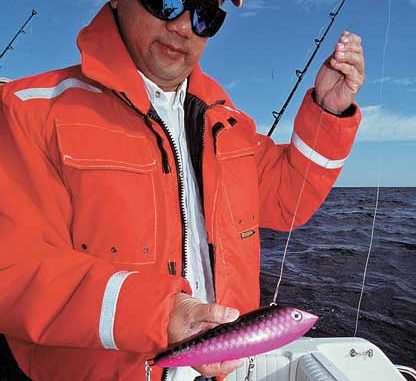
The biggest bad boys of the mackerel kingdom swim in N.C. waters each November.
While Anthony Ng has made his fishing reputation by catching a variety of bottomfish species, he also enjoys fishing for many other types of fish. From swordfish at 80 miles to shad at inland locations, he’s one of the top anglers at the central coast. It should come as no surprise that Ng also catches big kings.
“We fished a tournament the other day and caught a lot of kings, but not any big enough to finish in the money,” Ng said. “But it’s just now getting good. Everyone wants to fish during the spring, summer and early fall. But the king mackerel bite really heats up as the water cools in October and November.”
Ng lives in Winterville but keeps his boat at a marina in Atlantic Beach. He fishes from his 30-foot Grady White Bimini, a center-console boat with twin Yamaha 250-horsepower four-stroke engines.
“The boat design is great for king fishing,” Ng said. “You need a good stabile platform like that with plenty of fishing room because a king mackerel can take you all around the boat before you hit him with the gaff.
“You might find kings as far out as the Big Rock at 45 miles, or they could be right on the beach. You want a calm day for catching kings. But sometimes it’s only calm when you leave the dock. Then it gets really rough for the ride back in. That means you need a seaworthy boat in choppy seas.”
Similar to most other king fishermen, Ng prefers using live menhaden for bait. He catches them at the side of Harkers Island facing Cape Lookout or on his way out Beaufort Inlet. If the big schools of menhaden aren’t at either location, he looks for them between Barden and Beaufort Inlet by watching for birds diving into the baitfish schools.
“I use a Bett’s Pro 12-foot cast net with ¾-inch mesh for catching bait in the ocean,” Ng said. “It’s a big, heavy, fast-sinking net. I’m throwing it in up to 30 feet of water so it has to sink fast enough that menhaden can’t swim out from beneath it.”
Ng has a built-in live well for keeping his menhaden alive. The live-well capacity is 50 gallons, and he puts no more than 30 to 40 menhaden in it for the trip offshore.
“If you put too many baits in the well, they begin to die rather quickly,” he said. “One big menhaden per gallon of live well capacity is about right. My system has a diverter called a Full Column Distribution Inlet and Outboard Drain system, which is a standard system on Grady White Boats. It keeps fresh water entering the live well at all levels so there are no dead spots.”
Despite everything he does to keep his live menhaden lively, Ng has lost his baits through a pump malfunction or by passing through water conditions that have killed them. He blames red tide or other unknown factors for fickle baitfish die-offs.
“I always have a backup bait plan,” he said. “I carry some Sabiki rigs to jig up some cigar minnow and sardines. I also always carry along some frozen cigar minnows and ballyhoo. If I don’t need them, I just keep them frozen for a future trip.”
In November Ng finds really big king mackerel east of Cape Lookout. Chicken Rock, 1700 Rock and Atlas Tanker are some of the better known bottoms structures that are notorious for producing large king mackerel.
“I look for water temperatures ranging from 67 to 72 degrees,” he said. “When I find them, I start getting down to business. Any hard ledge or hard structure where there are the right temperature breaks that also has baitfish is going to have kings. But you might find kings just by working the temperature breaks as far north as Cape Hatteras.”
Ng, who owns Fish-Ng Accessories (which manufactures custom rod holders and Precision Auto Reels), said nobody has enough rod holders on a boat. When he gets offshore, he typically uses four live-bait rods for king mackerel fishing and sometimes uses five. But he also takes along a couple of reels rigged with electric-assist devices mated to heavy rods. If he catches his limit of kings, he often goes bottom fishing. But he also uses the heavy electric gear for catching kings and other fish.
“When you locate the right water temperature, it doesn’t mean you’ve found fish,” Ng said. “I use two electric reels on grouper rods while I’m looking for kings, trolling them at 6 or 7 knots,” he said. “I add a top shot of 20 feet of 80-pound test mono to the heavy braid I use for bottom fishing. Trolling a Braid Marauder, which is a swimming wahoo lure or a Tsunami Tremor Sinking Lure at that speed will entice not only big kings but wahoo and yellowfin tuna. I like the 4 ¾-ounce Tsunami lure the best.”
Ng circles the area, watching the depth-finder for kings and schools of baitfish. At that speed, if the reel sounds off, the fish can gain lots of line before the boat turns toward the fish. At that point, all the angler has to do is push the button on the reel and bring the king in like catching a big Spanish mackerel
“I stagger the two so the lines don’t get tangled,” Ng said. “Sometimes you’ll catch two fish at the same time. I mark the spot with my GPS and catch the first king. Now that I’ve located the fish, I switch to live baits. If I just want to boat some kings and go bottom fishing afterward, I may just keep using the electric reels.”
For live bait fishing, Ng uses 7-foot Tsunami rods and Shimano TLD 15 reels spooled with 20- to 25-pound test Stren monofilament line. His live bait rigs are tied with 3 feet of 42-pound single-strand, two No. 4 treble hooks and a 75-pound test extra strong swivel connection to the main line.
“I start with four rods — two in the T-top and two off the stern rod-holder,” Ng said. “Some people use more rods, but I don’t want to catch too many kings at one time. I might put one more rod on a down-rigger if conditions are good for using a down-rigger and I don’t get bites on surface.”
Ng puts his down-rigger bait at the depth he spots fish with his sonar or at half the water depth if he doesn’t see many baitfish or sees baitfish from top to bottom. He usually uses a live bait on the down-rigger, but sometimes puts a ribbonfish on the deep line.
“I catch my own ribbonfish in the fall and brine them and freeze them,” he said. “I use brine of baking soda and salt and use a vacuum sealer to keep them fresh and shiny. I use a chartreuse Hank Brown jig head to hold the ribbonfish and tie as many treble hooks behind it on the leader as it takes to cover the ribbonfish. It might take six hooks to cover a 30- to 36-inch ribbonfish with enough hooks. A ribbonfish attracts some really big king mackerel because of its size. Use a bigger bait, and you will catch a bigger king.”
For fishing frozen baits, Ng uses the same live bait rig as he uses for trolling with menhaden. Sometimes he uses a different rig for ballyhoo to make it swim properly. If the bait won’t swim true, he uses a 3/8- to ½-ounce chartreuse jig head in the nose of the ballyhoo followed by a single treble hook hanging free beside the tail.
“Sometimes we mix the live and dead baits together in the same spread,” he said. “But if we use only dead baits, we can troll a little faster.
“If sharks eat all all your live baits, you should move to another area before putting down the expensive frozen baits. I hate to feed one of my ribbonfish or a box of cigar minnows to fish I don’t want to catch.”
The reason Ng likes fishing for kings when other anglers stay home is the fish are bigger than at any other time of year. The fish are monsters, compared to spring and summer kings.
“My average-size fish weighs 30 to 40 pounds and some fish are up there in the 50- and 60-pound range,” he said. “You never know when you might run over a wahoo. If you catch a wahoo on a live bait set up, he might spool you. I caught one over 80 pounds while red grouper fishing. We were tossing a fish over and heard a big splash. I saw a wahoo lying there, waiting for another fish. I rigged up a live bait on one of the king rods and hooked him up. It me took an hour and a half to (land) him.”
When the really big kings are biting, Ng sometimes super-sizes his live-bait rigs. He increases wire size to 60 pounds and switches from No. 4 treble hooks to No. 2 trebles.
“No matter which rig you use, keeping the pressure light is the key to landing a big king with live bait,” Ng said. “I use 2 or 3 pounds of drag. When he runs off that first 200 to 300 yards, I chase him down with the boat. Once he tires, I use a long gaff to land him. I use a 2-inch (gaff) hook for kings because a larger hook will go around the fish. I take the shoulder shot because it gives the most control of the fish and won’t tear free.”
Ng often fishes with his friend, Jimmy Dupree Jr. of Tarboro. Dupree fishes many king mackerel tournaments from his 31-foot Contender, OBX Girl/King Calcutta which is equipped with twin 250-hp four-stroke Yamaha engines. Dupree also fishes with his two sons, Jimmy Dupree III and Dan.
“It’s a great time of year for taking your family and friends,” Dupree said. “We go out across the shoals to the East Side of Cape Lookout because that’s where the big kings first show up. Later on, we move back south of the Morehead City area when the fish move into Onslow Bay. But you have to stay in contact with other anglers because the fish could move as far north as Bad Bottoms up off Cape Hatteras.”
Dupree said the air temperatures aren’t stifling and the fish he catches from Cape Lookout to Cape Hatteras weigh as much as 55 pounds. He wonders why more king tournaments aren’t held during the late fall and early winter because it’s really the best time to catch big kings.
“It’s the red-hot holidays,” he said. “You miss the hurricane season and all the heat and tourists. I like it cold and blustery.”
Dupree prefers bluefish baits for catching outsized kings. He catches bluefish the day before he goes king mackerel fishing, using Clarkspoons rigged with No. 2 planers.
He finds schools of bluefish near Oceanna Pier near Beaufort Inlet and trolls just off the beach.
“Bluefish swim better than menhaden,” he said. “Kings love eating bluefish. I keep them in a bait pen overnight; it has a top so they don’t jump out.”
Dupree fishes Shimano rods and reels as does Ng. His bluefish rig is tied with No. 5 single-strand wire and has a single No. 2 Mustad nose hook and one Eagle Claw 4x strong treble hook. He ties the rig to a 15-foot length of 30-pound clear Calcutta fluorocarbon using a nail knot and ties the fluorocarbon to the main line using a 35-pound Spro swivel.
“There aren’t many secrets to catching a big king mackerel anymore,” Dupree said. “Everybody uses fluorocarbon leaders and big baits now. The biggest secret left is the holiday bite.
“Go now and you’ll catch the biggest kings you’ve ever seen.”

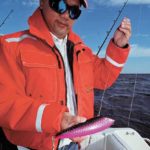
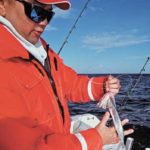
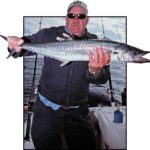
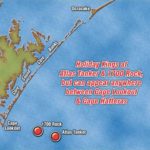
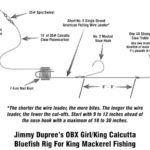
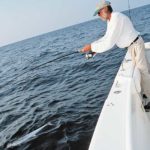
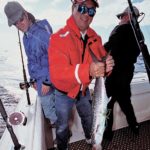

Be the first to comment